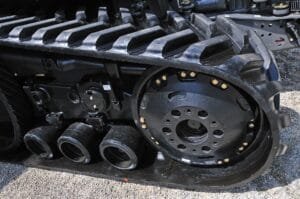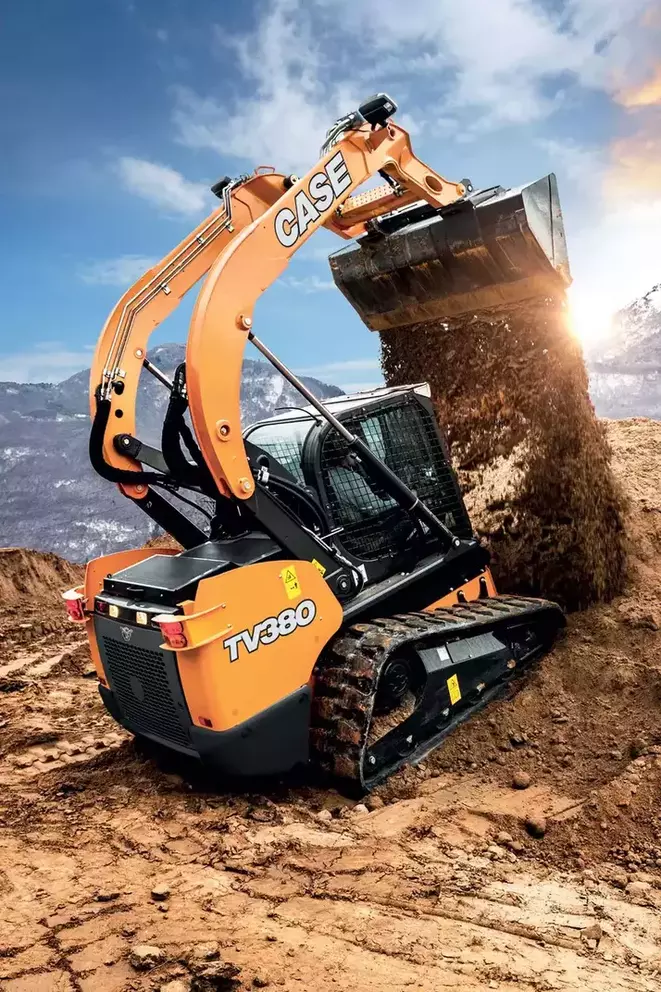Rubber tracks and steel tracks each come with their own set of strengths and trade-offs. The better option isn’t always obvious — it depends on where and how the machine will be used. Factors like terrain, load, surface sensitivity, noise requirements, and budget constraints all play a role. For example, a compact snow-clearing vehicle working on paved roads has very different needs than a forestry machine navigating rocky, uneven ground. That’s why choosing the right type of track is less about picking the “strongest” or “most popular” — and more about choosing what’s truly fit for purpose.
Let’s walk through the differences, the real-world pros and cons, and how to make the right choice — from someone who’s been in the game for 20 years (hi, that’s us 👋).
Table of Contents
ToggleRubber Tracks: Flexible, Quiet, and Surface-Safe
Rubber tracks are ideal for applications where ground protection, comfort, and noise control matter. Snowmobiles, compact construction equipment, agricultural machinery, and robots often run better — and smoother — on rubber.
Why Rubber Might Be Right for You:
- Protects the Ground – Whether it’s pavement, grass, or indoor floors, rubber tracks won’t tear up the surface.
- Lower Vibration – Keeps the ride smoother for operators and reduces wear on machines.
- Lighter Weight – Easier to transport, better fuel economy.
- Noise Reduction – Much quieter than steel, ideal for urban or quiet-zone jobs.
- Customizable Tread Options – Choose from straight bar, multi-bar, staggered block, or C-lug patterns depending on your terrain.

But Watch Out For:
- Tough Terrain Wear – Rocks, demolition debris, or sharp surfaces can shorten rubber track life.
- Less Traction in Mud/Slopes – Especially in steep, wet, or icy areas.
- One-piece Design – If the track breaks, it usually needs full replacement.
Steel Tracks: Heavy-Duty, Built for Brutal Conditions
If your machine’s job is to climb, dig, or demo, steel tracks bring the muscle. Excavators, forestry machines, and large-scale equipment rely on the durability and weight distribution of steel.
When Steel Tracks Shine:
- Superior Durability – Ideal for demolition, forestry, or long-term use in rough terrain.
- Stability – Adds counterweight, lowers center of gravity, reduces tipping risk.
- Excellent Traction – Performs better on steep slopes, icy ground, or unstable surfaces.
- Replaceable Links – Break a link? Replace it. No need to change the whole track.
Consider These Drawbacks:
- Harsh on Surfaces – Will damage roads, lawns, or delicate ground.
- Noisier – Clanks and rattles on hard surfaces.
- Less Comfort – More vibration and jolts for the operator.
- Heavier – Adds weight, which can increase ground pressure or transport complexity.
- Higher Upfront Cost – Plus, steel undercarriages tend to require more maintenance.
Which Track Is Right for You?
Rubber and steel tracks each have their advantages, and the right choice depends on your machine’s working conditions. If you’re operating on hard, flat, or delicate surfaces, rubber tracks are ideal — they’re quieter, gentler on the ground, and provide a smoother ride. On the other hand, if your equipment tackles rough, soft, or uneven terrain, steel tracks offer better traction, durability, and stability. The key is matching the track type to your specific application for optimal performance and longevity.
At VEJEETRACK, we’re more than just a factory — we’re your technical partner. With over 20 years of experience, we help OEMs and engineers choose the right track for any machine or terrain.
✅ Factory-direct pricing— no middlemen, no markup
✅ Custom R&D and mold design — tailored to your machine, environment, and performance goalsm R&D and mold design
✅ All-weather, lab-tested materials — built to perform in snow, mud, ice, or heat
✅ Flexible customization — from sizing and tread to logo and branding
Tracks for All Kinds of Equipment
We supply tracks for:
- Rubber-tracked loaders & compact track machines
- Mini excavators & standard excavators
- Skid steer Over the tire track systems
- Trenchers & boring equipment
- Asphalt pavers & profilers
- Haulers and dumpers
- Tracked construction equipment
- Carriers & utility equipment
- Road machinery
- Aerial lifts & cranes
We manufacture high-quality tracks for a wide range of machines. Whether you’re in the construction, forestry, agricultural, and landscaping industries— we’ve got you covered.

Built for your machine. Backed by our experience. Ready for your next project.


